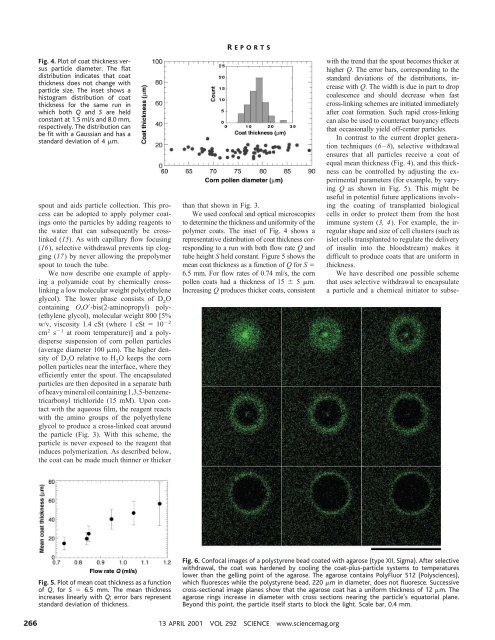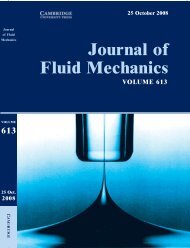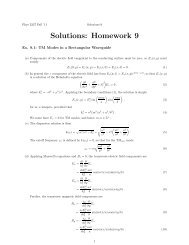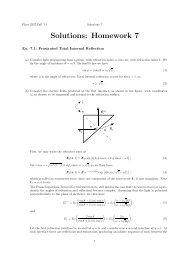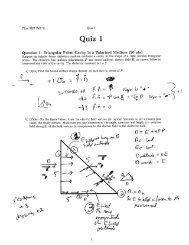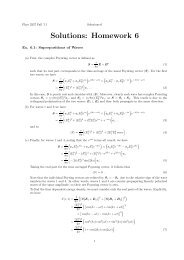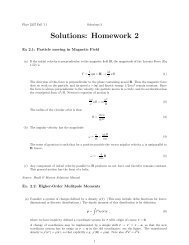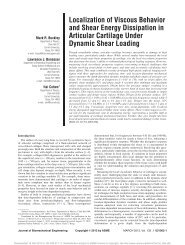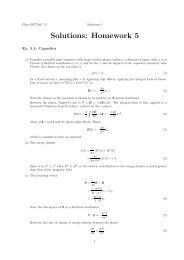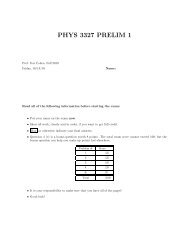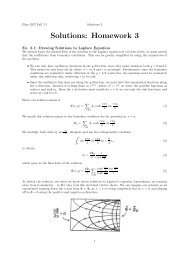Using Selective Withdrawal to Coat Microparticles - Itai Cohen Group
Using Selective Withdrawal to Coat Microparticles - Itai Cohen Group
Using Selective Withdrawal to Coat Microparticles - Itai Cohen Group
Create successful ePaper yourself
Turn your PDF publications into a flip-book with our unique Google optimized e-Paper software.
Fig. 4. Plot of coat thickness versus<br />
particle diameter. The flat<br />
distribution indicates that coat<br />
thickness does not change with<br />
particle size. The inset shows a<br />
his<strong>to</strong>gram distribution of coat<br />
thickness for the same run in<br />
which both Q and S are held<br />
constant at 1.5 ml/s and 8.0 mm,<br />
respectively. The distribution can<br />
be fit with a Gaussian and has a<br />
standard deviation of 4 m.<br />
spout and aids particle collection. This process<br />
can be adopted <strong>to</strong> apply polymer coatings<br />
on<strong>to</strong> the particles by adding reagents <strong>to</strong><br />
the water that can subsequently be crosslinked<br />
(15). As with capillary flow focusing<br />
(16), selective withdrawal prevents tip clogging<br />
(17) by never allowing the prepolymer<br />
spout <strong>to</strong> <strong>to</strong>uch the tube.<br />
We now describe one example of applying<br />
a polyamide coat by chemically crosslinking<br />
a low molecular weight poly(ethylene<br />
glycol). The lower phase consists of D 2<br />
O<br />
containing O,O-bis(2-aminopropyl) poly-<br />
(ethylene glycol), molecular weight 800 [5%<br />
w/v, viscosity 1.4 cSt (where 1 cSt 10 2<br />
cm 2 s 1 at room temperature)] and a polydisperse<br />
suspension of corn pollen particles<br />
(average diameter 100 m). The higher density<br />
of D 2<br />
O relative <strong>to</strong> H 2<br />
O keeps the corn<br />
pollen particles near the interface, where they<br />
efficiently enter the spout. The encapsulated<br />
particles are then deposited in a separate bath<br />
of heavy mineral oil containing 1,3,5-benzenetricarbonyl<br />
trichloride (15 mM). Upon contact<br />
with the aqueous film, the reagent reacts<br />
with the amino groups of the polyethylene<br />
glycol <strong>to</strong> produce a cross-linked coat around<br />
the particle (Fig. 3). With this scheme, the<br />
particle is never exposed <strong>to</strong> the reagent that<br />
induces polymerization. As described below,<br />
the coat can be made much thinner or thicker<br />
R EPORTS<br />
than that shown in Fig. 3.<br />
We used confocal and optical microscopies<br />
<strong>to</strong> determine the thickness and uniformity of the<br />
polymer coats. The inset of Fig. 4 shows a<br />
representative distribution of coat thickness corresponding<br />
<strong>to</strong> a run with both flow rate Q and<br />
tube height S held constant. Figure 5 shows the<br />
mean coat thickness as a function of Q for S <br />
6.5 mm. For flow rates of 0.74 ml/s, the corn<br />
pollen coats had a thickness of 15 5 m.<br />
Increasing Q produces thicker coats, consistent<br />
with the trend that the spout becomes thicker at<br />
higher Q. The error bars, corresponding <strong>to</strong> the<br />
standard deviations of the distributions, increase<br />
with Q. The width is due in part <strong>to</strong> drop<br />
coalescence and should decrease when fast<br />
cross-linking schemes are initiated immediately<br />
after coat formation. Such rapid cross-linking<br />
can also be used <strong>to</strong> counteract buoyancy effects<br />
that occasionally yield off-center particles.<br />
In contrast <strong>to</strong> the current droplet generation<br />
techniques (6–8), selective withdrawal<br />
ensures that all particles receive a coat of<br />
equal mean thickness (Fig. 4), and this thickness<br />
can be controlled by adjusting the experimental<br />
parameters (for example, by varying<br />
Q as shown in Fig. 5). This might be<br />
useful in potential future applications involving<br />
the coating of transplanted biological<br />
cells in order <strong>to</strong> protect them from the host<br />
immune system (3, 4). For example, the irregular<br />
shape and size of cell clusters (such as<br />
islet cells transplanted <strong>to</strong> regulate the delivery<br />
of insulin in<strong>to</strong> the bloodstream) makes it<br />
difficult <strong>to</strong> produce coats that are uniform in<br />
thickness.<br />
We have described one possible scheme<br />
that uses selective withdrawal <strong>to</strong> encapsulate<br />
a particle and a chemical initia<strong>to</strong>r <strong>to</strong> subse-<br />
Fig. 5. Plot of mean coat thickness as a function<br />
of Q, for S 6.5 mm. The mean thickness<br />
increases linearly with Q; error bars represent<br />
standard deviation of thickness.<br />
Fig. 6. Confocal images of a polystyrene bead coated with agarose (type XII, Sigma). After selective<br />
withdrawal, the coat was hardened by cooling the coat-plus-particle systems <strong>to</strong> temperatures<br />
lower than the gelling point of the agarose. The agarose contains PolyFluor 512 (Polysciences),<br />
which fluoresces while the polystyrene bead, 220 m in diameter, does not fluoresce. Successive<br />
cross-sectional image planes show that the agarose coat has a uniform thickness of 12 m. The<br />
agarose rings increase in diameter with cross sections nearing the particle’s equa<strong>to</strong>rial plane.<br />
Beyond this point, the particle itself starts <strong>to</strong> block the light. Scale bar, 0.4 mm.<br />
266<br />
13 APRIL 2001 VOL 292 SCIENCE www.sciencemag.org


